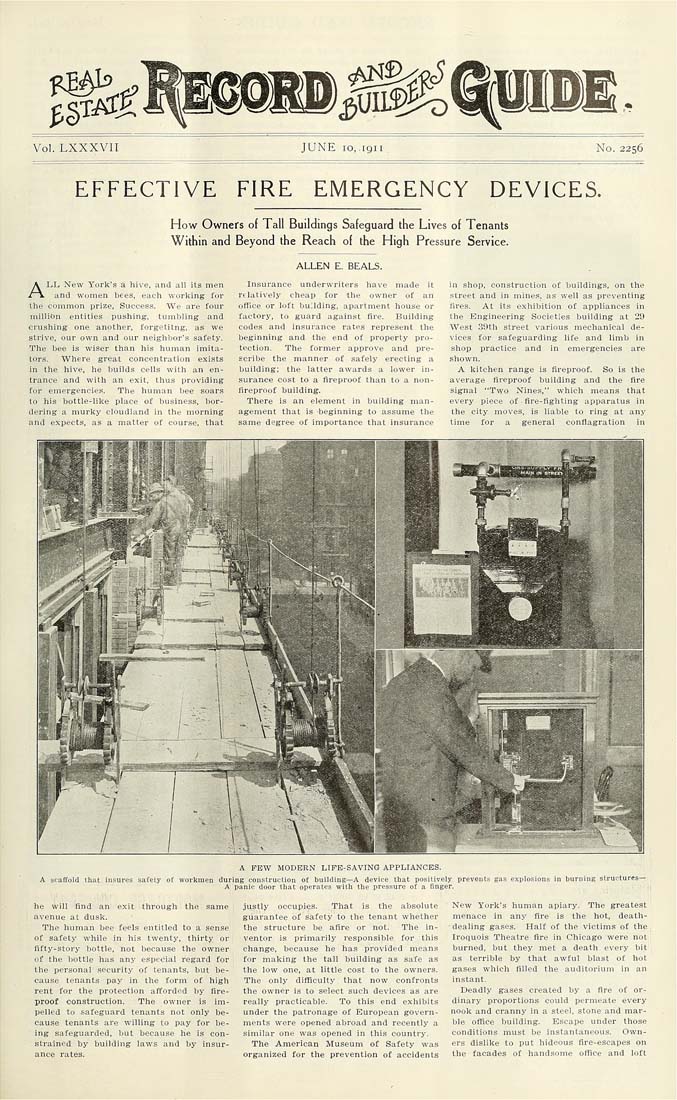Please note: this text may be incomplete. For more information about this OCR, view
About OCR text.
<i^B^S
wmM
Vol. LXXXVII
JUNE io,.r9ii.
No. 2256
EFFECTIVE FIRE EMERGENCY DEVICES.
How Owners of Tall Buildings Safeguard the Lives of Tenants
Within and Beyond lhe Reach ol the High Pressure Service.
ALL New York's a hive, ana all its men
and women bees, each working for
the common prize, Success. We are four
million entities pusliing, tumbling and
crushing one another, forgetitng, as we
strive, our own and our neighbor's safety.
The bee is wiser than his human imita¬
tors. Where great concentration exists
in the hive, he builds cells with an en¬
trance and with an exit, thus providing
for emergencies. The human bee soars
lo his bottle-like place of business, bor¬
dering a murky cloudiand in the morning
and expects, as a matter of course, that
ALLEN E. BEALS.
Insurance underwriters have made it
relatively cheap for the owner of an
office or loft building, apartment house or
factory, to guard against fire. Building
codes and insurance rates represent the
beginning and tbe end of property pro¬
tection. The former approve and pre¬
scribe the manner of safely erecting a
building; the latter awards a lower in¬
surance cost to a flreproof than to a non-
fireproof building.
There is an element in building man¬
agement that is 'beginning to assume the
same degree of importance that insurance
in shop, construction of buildings, on the
street and in mines, as well as preventing
fires. At its exhibition of appliances in
the Engineering Societies building at 29
West r!!)th street various mechanical de¬
vices for safeguarding life and limb in
shop practice and in emergencies are
shown.
A kitchen range is fireproof. So is the
average fireproof building and the flre
signal "Two Nines," which means that
every piece of ■ fire-flghting apparatus in
the city moves, is liable to ring at any
time for a general conflagration in
A FEW MODERN LIFE-SAVING APPLIANCES.
A scaffold that insures safety of workmen during construction of builcling—A device that positively prevents gas explosions in burning structures—
A panlr door tbat operates with the pressure of a finger.
he will find an exit through the same
avenue at dusk.
The human bee feels entitled to a sense
of safety while in liis twenty, thirty or
flfty-story bottle, not Isecause the owner
of tbe bottle has any especial regard for
the personal security of tenants, but be¬
cause tenants pay in the form of high
rent for ttie protection afforded by fire¬
proof construction. The owner is im¬
pelled to safeguard tenants not only be¬
cause tenants are willing to pay for be¬
ing sateguarded, but because he is con¬
strained by building laws and by insur¬
ance rates.
justly occupies. That is the absolute
guarantee of safety to the tenant whether
the structure be afire or not. The in¬
ventor is primarily responsible for this
change, because he has provided means
for inaking the tail building as safe as
the low one, at little cost to the owners.
The only difficulty that now confronts
the owner is to select such devices as are
really practicable. To this end exhibits
under the patronage of European govern¬
ments were opened abroad and recently a
similar one was opened in this country.
The American Museum of Safety was
organized for the prevention of accidents
New York's human apiary. The greatest
menace in any fire is the hot, death-
- dealing gases. Half of the victims of the
Iroquois Theatre flre in Chicago were not
burned, but they met a death every bit
as terrible by that awCuI blast of hot
gases which filled the auditorium in an
instant.
Deadly gases created by a flre of or¬
dinary proportions could permeate every
nook and cranny in a steel, stone and mar¬
ble office building. Escape under those
conditions must be instantaneous. Own¬
ers dislike to put hideous fire-escapes on
the facades of handsome offlce and loft








